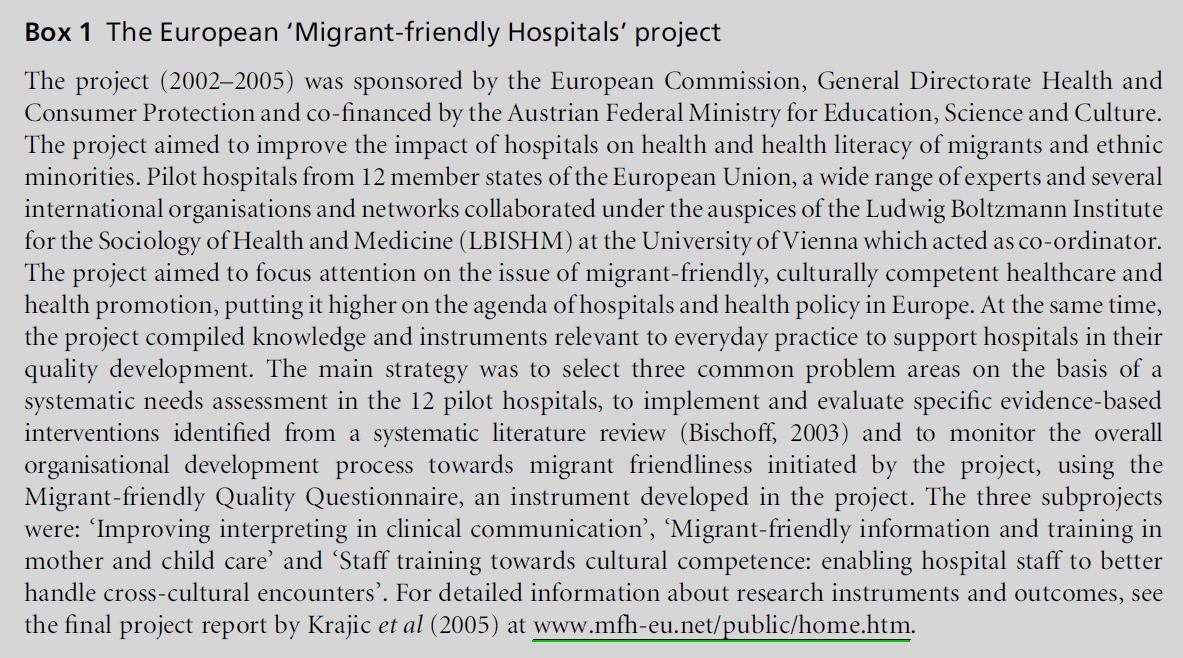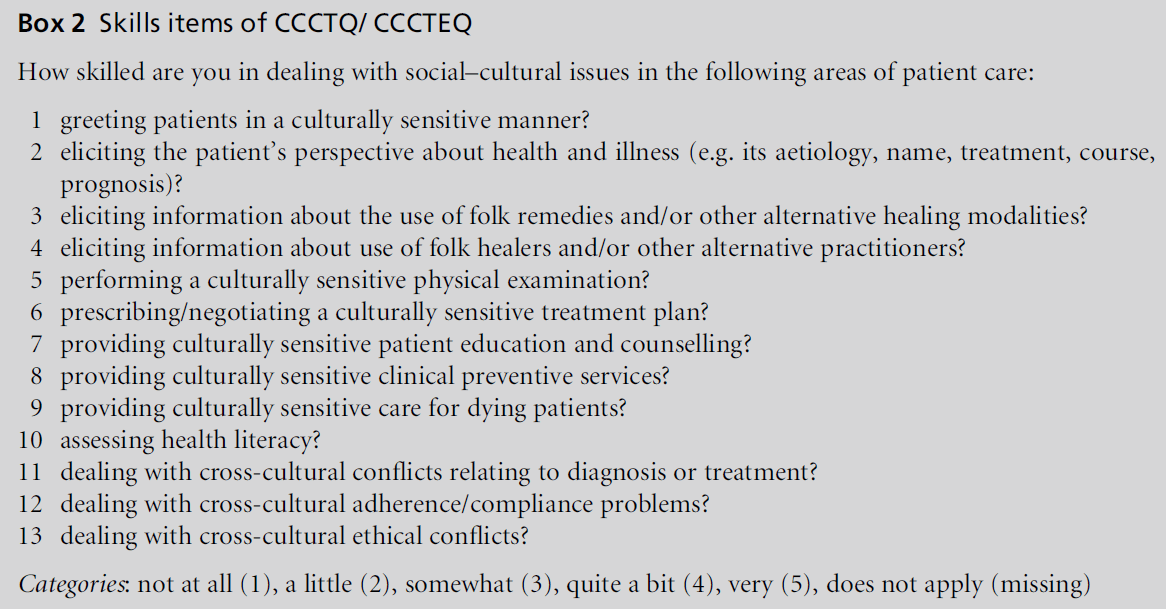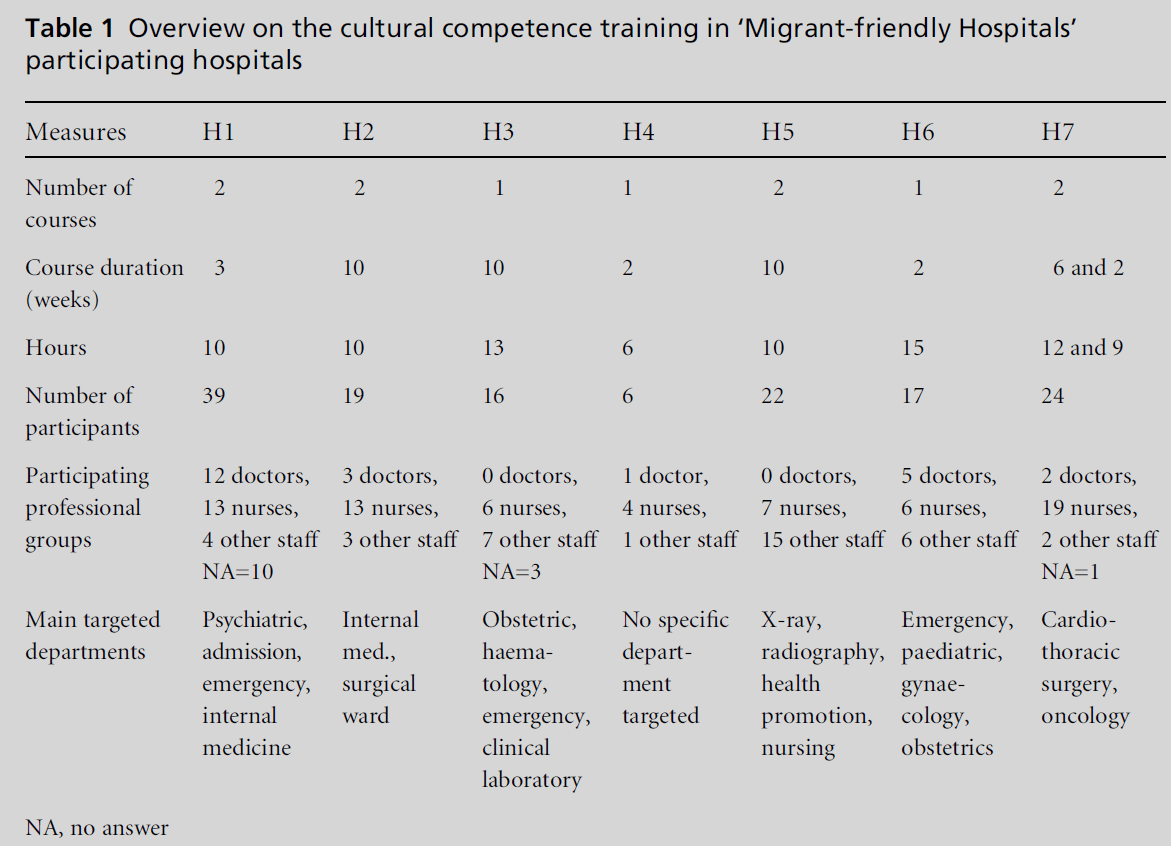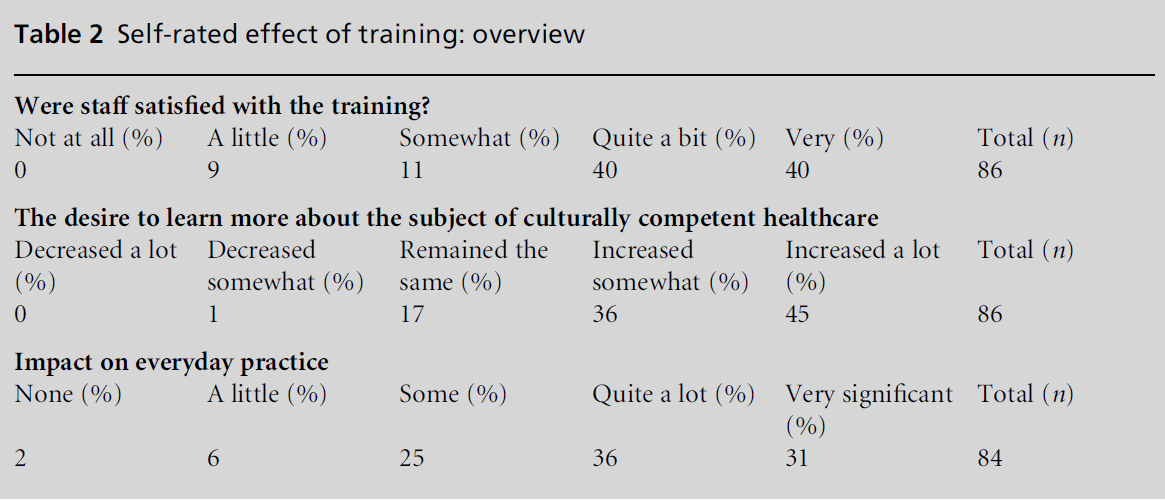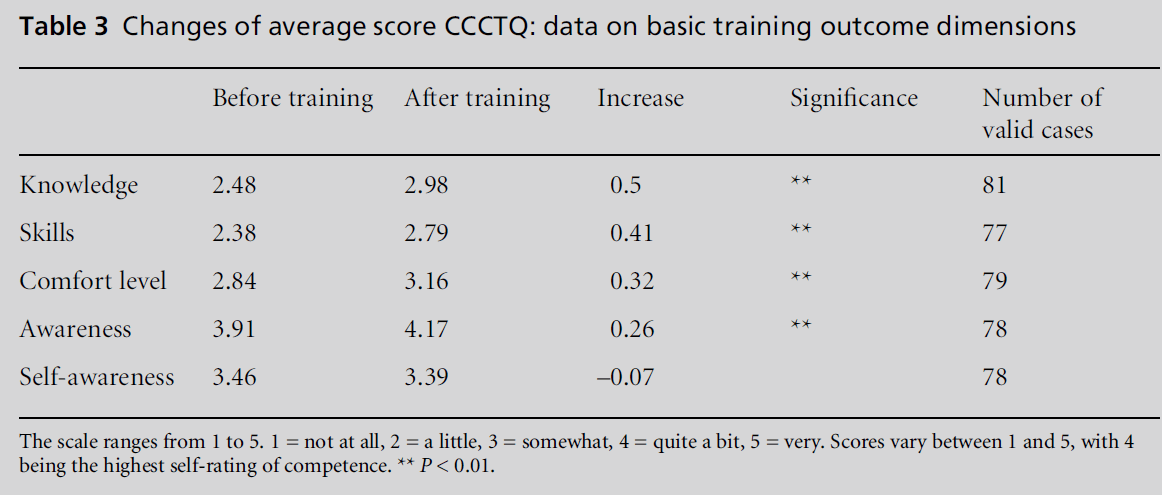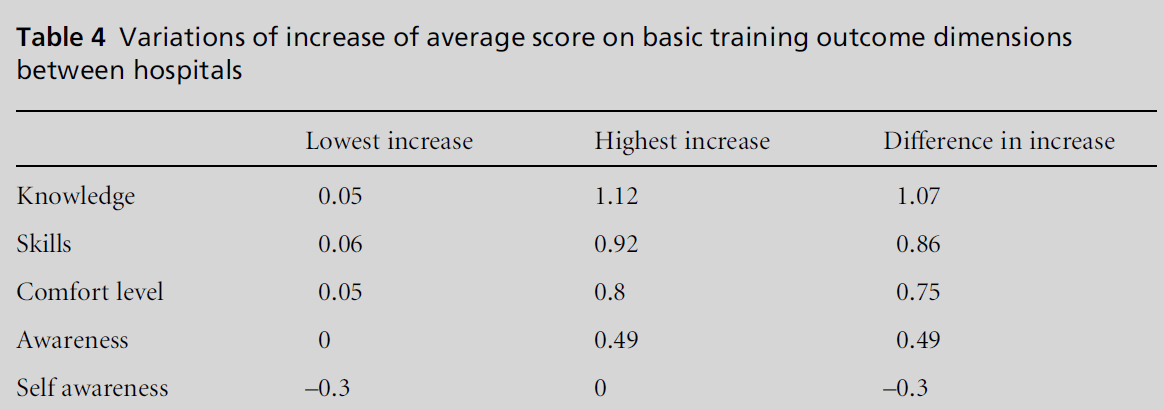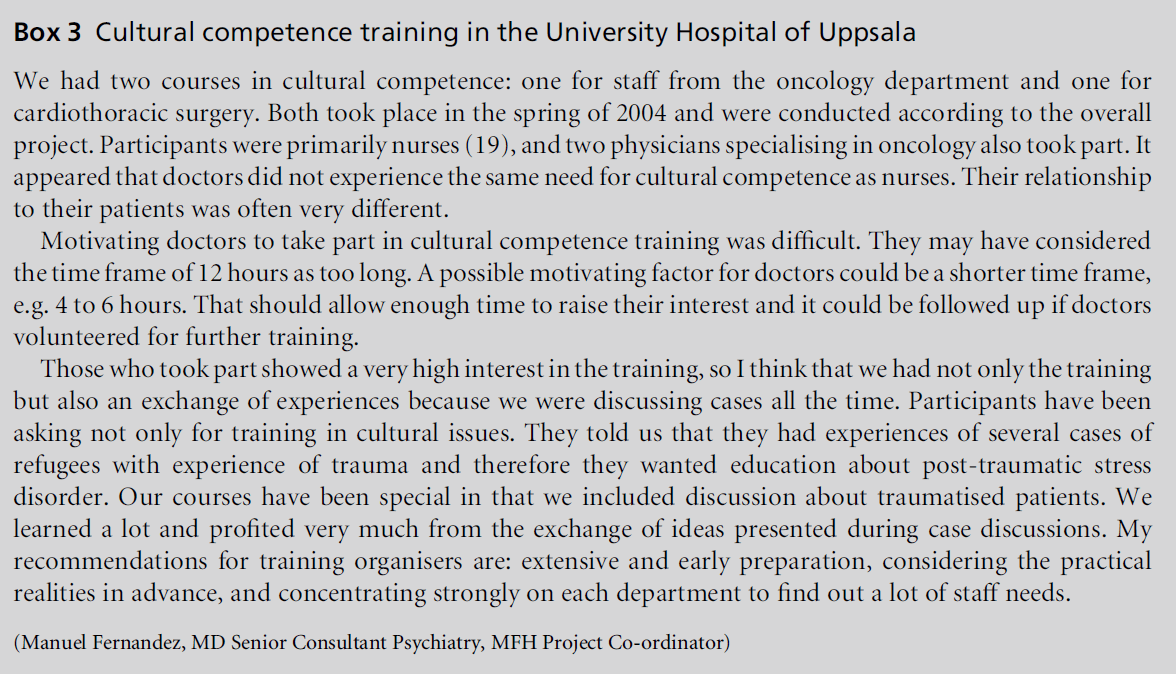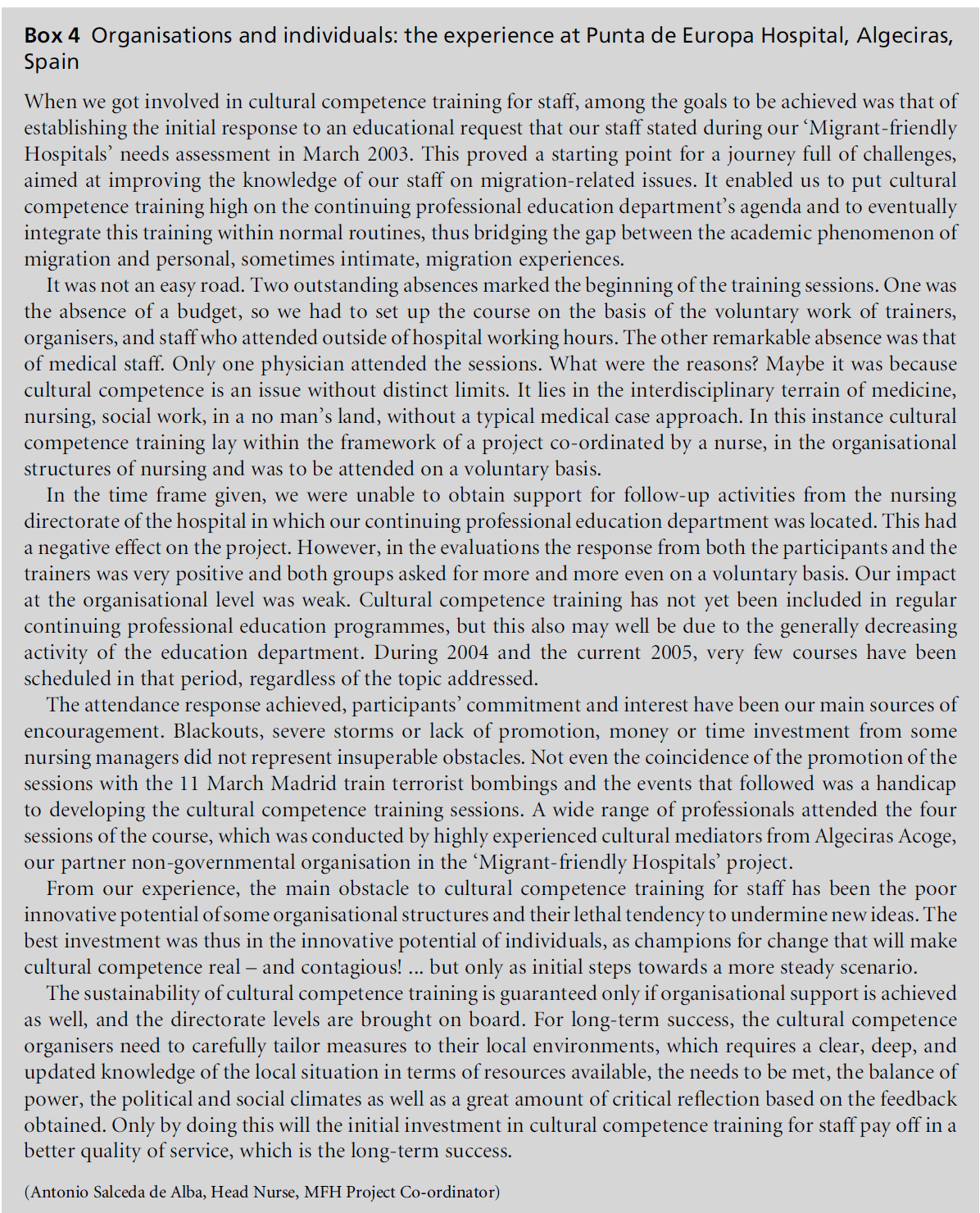Key words
cultural competence training, hospital
staff, management support, multi-hospital implementation
and evaluation, training design, trainers’
profiles
Introduction
Europe is becoming more and more ethnically and
culturally diverse as a result of increasing mobility
within the European Union, tourism and migration
(Koehn, 2004). In this context the cultural competence
of health professionals and healthcare organisations
has become one of the key issues in discussions about
health policy and the quality of service provision in
relation to health disparities/inequalities fields (Brach
and Fraser, 2000). These discussions have been particularly
prominent in the United States and with
increasing intensity during the last ten years (McBride,
2005). According to Cross et al (1989) ‘cultural competence
is a set of congruent behaviours, attitudes, and
policies that come together in a system, agency or
amongst professionals and enables that system, agency,
or those professionals to work effectively in crosscultural
situations’. This definition has been widely
adapted and modified in the past years and has served,
especially in the USA, as a basis for further conceptual
and practical work, e.g. Health Resources and Services
Administration (2001), Betancourt et al (2002) and
Goode and Dunne (2003). It has also informed the
development of the standards for culturally and
linguistically appropriate services (CLAS) (United States
Department of Health and Human Services (HHS)
Office of Minority Health and Resources for Cross
Cultural Health Care, 1999). Cultural competence is
considered important because, it is argued, culture
influences people’s perceptions of the causes of health
and disease, their experiences of illness and how they
express their symptoms. In addition, culture impacts
on their help-seeking behaviours, decisions about
treatment and compliance with recommendations
(Cohen and Goode, 2003). It seems only plausible
that a clash of diverse expectations or perhaps even a
failure to recognise differences in comprehension and
expectations is likely to generate conflicts and quality
problems.
The traditional approach used in many programmes,
projects and initiatives that address cultural competence
has been to focus on the intercultural (transcultural/
transnational) behaviour of key healthcare providers
like nurses or physicians alongside the dimensions of
cultural awareness, knowledge and related skills (see
for example Campinha-Bacote, 1994). In this approach,
competence is understood as something that varies
between individuals and which can be supported by
training in the same way as other professional skills.
The authors are aware of the ongoing and very important
discussion about this approach including new
concepts such as cultural humility as an alternative to
cultural competence (Tervalon and Murray-Garcia,
1998), transnational competence (Koehn, 2004) and
transcultural nursing (e.g. Papadopoulos et al, 2004). However, these are not explored here because the
project reported in this paper used the traditionally
accepted approach to cultural competence training.
Cultural competence training has been widely promoted
as part of continuous professional education
and adopted as a measure for quality assurance and
improvement in the United States as a likely shortterm
impact (Health Resources and Services Administration,
2001; Betancourt et al, 2002). Evidence of the
effectiveness of cultural competence training is, so far,
not very strong mainly due to a lack of controlled
studies, with special weaknesses concerning the measurement
of the effects on patients and their health (see
a series of newly published reviews: Anderson et al,
2003; Fortier and Bishop, 2004; Beach et al, 2005; Price
et al, 2005). However, current literature was sufficiently
convincing for eight European hospitals to
implement and evaluate cultural competence training
for staff as part of the European ‘Migrant-friendly
Hospitals’ project (see Box 1). The experiences and
outcomes of this implementation are presented in this
paper. These outcomes are of direct relevance to hospitals
and other healthcare organisations interested in
staff support and quality improvement and also have
implications for the further research agenda on cultural
competence training.
Handling cultural diversity as a
common problem area in
European hospitals
A needs assessment conducted at the beginning of
the project identified staff difficulties in dealing with
(ethno) cultural diversity as one of the most important
problems in 10 out of 12 hospitals (Schulze et al,
2003). Staff experienced problems in understanding
migrant patients’ symptoms, communicating treatment
options and decisions and generally developing relationships
with patients. Different and unknown assumptions,
expectations and conceptions about the
client–provider relationship were reported as leading
to conflicts between migrants and staff, especially
when coupled with a lack of awareness about culture,
misunderstandings and prejudices. Eight participating
hospitals agreed to conduct a cultural competence
training initiative for six months, from January until
June 2004. The primary goal was to make staff feel
more comfortable in cross-cultural situations by providing
them with relevant knowledge and skills. An
actual improvement in the quality of care was expected
to follow from this, but partners agreed that systematic
monitoring of this change would be methodologically
difficult and out of the narrow time frame
of the project.
Box 1: The European ‘Migrant-friendly Hospitals’ project
Research objectives
The first objective of the initiative was to test the
feasibility of cultural competence training in various
types of hospitals in diverse national and local situations
through the collection of data about factors that
enhanced or hindered implementation. A systematic
feasibility study was appropriate as only a few European
countries, such as theUK, had so far introduced policies,
programmes and projects about cultural competence
and there was little evidence that ethnocultural diversity
played any major role in quality discussions in
European healthcare. Given this marginal position, an
investigation into the cost-effectiveness and sustainability
of cultural competence training seemed useful.
A semi-standardised
intervention
A common approach to cultural competence training,
known as the ‘Pathway’, and modular content (see
Krajic et al, 2005) were developed. The common
approach was based especially on the work of Like
et al (1996), Carrillo et al (1999), Gilbert (2003a),
Anand (1999) and Welch (2003). Using the same
approach provided common ground for planning
and delivering the training, monitoring quality and
discussing the outcomes of the evaluation. Although a
higher degree of standardisation, including agreement
on a shared model, would have been most useful from
a research perspective, it was not possible to find a consensus due to time and resource constraints.
Nevertheless, the ‘Pathway’ provided guidance and
orientation for planning, organising and implementing
as well as evaluating cultural competence training.
The core recommendations for implementing the
‘Pathway’ and the modules in each hospital were to:
• obtain strong support frommanagement to ensure
that staff would accept and participate in the
training and to secure the necessary financial and
material resources such as providing a venue,
materials and trainer fees
• emphasise that cultural competence training was
voluntary but endorsed by management, that it
would carry credits for continuing professional
education and that it would take place during
regular working time
• focus on two or three pilot departments that
volunteered to be the first to undergo training
although, in the long run, training would be offered
to all staff
• conduct needs assessments at department level to
identify specific training needs and to facilitate
tailoring of the course material to the everyday
work encounters and problems experienced by staff
• select competent trainers, either individuals or
groups, and work with them to develop specific
content around issues of awareness, knowledge,
skills and follow-up sessions based on experiential
learning
• plan 10 hours training over a period of about 10
weeks to allow for experiential learning
• use interactive teaching designs
• decide on the mix of participants
• evaluate the training in a before-and-after design.
Methodology
The evaluation of the training was based on five
criteria: feasibility and acceptability; quality of implementation;
effectiveness; cost-effectiveness and sustainability
of the training. A range of measures was
developed. These included documentation sheets, progress
reports, telephone interviews and group discussion
with key people in each hospital. To assess the quality
of implementation, the ‘Pathway’ and modules served
as standards against which to compare qualitative and
quantitative information provided by each hospital.
The effectiveness of cultural competence training
for staff was measured in questionnaires that were
administered before, theCCCTQ-PRE (65 items), and
after, the CCCTEQ-POST (59 items), the training.
These instruments were developed on the basis of the
Clinical Cultural Competency Questionnaire (CCCQ)
developed initially for work with physicians by Like
(2004) at the UMDNJ–Robert Wood Johnson Medical
School, NJ. Like kindly gave permission for the use of
the CCCQ, and the tool was further developed for use
with a variety of health professionals in seven
European languages (see Krajic et al, 2005; www.
mfh-eu.net/public/experiences_results_tools/cct_eval_
instruments.htm).
The study measured changes in participants’ awareness,
knowledge, skills and comfort levels related to
caring for members of culturally diverse populations
before and after training. In addition, interest in cultural
issues, satisfaction with the training and selfrated
impact on everyday practice were checked
retrospectively. Data were pooled, but variations between
the specific hospitals are also presented below.
Changes were analysed and are presented here on the basis of a group comparison. Within the areas of
awareness, self-awareness, knowledge, skills and comfort
level, the average score of all items has been
calculated. For testing significance, a t test was used.
The reliability and internal consistency of aggregated
dimensions were tested with confirmative factor
analysis for both surveys using SPSS. In the ‘knowledge’
domain, all items were accepted (Cronbach’s
alpha score > 0.9 in both pre- and post-survey). In the
‘skills’ domain, two items were excluded, leaving 13
items remaining (Cronbach’s alpha score > 0.87 in
pre- and post-survey). In the ‘comfort level’ domain,
nine of the 16 items were included (Cronbach’s alpha
score > 0.8). In the ‘awareness’ domain, two constructs
were identified: ‘awareness’ (Cronbach’s alpha
score > 0.84) and ‘self-awareness’ (Cronbach’s alpha
score > 0.82). One item had to be removed. See Box 2 for the ‘skills’ domain as an example of the items in the
questionnaire.
Characteristics of the population
and response rate
Out of 143 participating staff, 122 filled in the prequestionnaire,
98 the post-questionnaire. As not all
participants provided information for both surveys or
provided the relevant information to link the first with
the second questionnaire (date of birth), only 81 persons
could be included in the analysis. Useable responses
were received from 11 physicians (14%), 50 nurses
(62%) and 19 others (24%). The response rate for
nurses was 74%, considerably higher than for physicians
(48%) and others (50%).
Box 2: Skills items of CCCTQ/ CCCTEQ.
Outcomes of the cultural
competence training
Outcomes are presented here with regard to each of
the five criteria for the evaluation: the feasibility and
acceptability of cultural competence training; thequality
of the training; the effectiveness; the cost-effectiveness
and the sustainability of the training.
Feasibility and acceptability
Seven out of eight hospitals (from Austria, France,
Germany, Ireland, Italy, Spain and Sweden) managed
to implement cultural competence training within the
time scale of the project. A total of 143 staff participated
in parts of the training. Participation varied
between hospitals and between professional groups,
with more nurses in all hospitals taking part. In two
hospitals not a single physician participated (see Table 1).
Quality
The quality of the cultural competence training courses
varied a lot. In all seven hospitals, training addressed
awareness and knowledge. Skills were covered in five
hospitals. Interactive teaching methods were applied
in all hospitals. A departmentally focused approach
was realised in six hospitals. Specific needs assessments
to ensure the practical relevance of training were undertaken in five hospitals. The performance of
the trainer was judged unsatisfactory by project coordinators
in two hospitals. Follow-up sessions using
experiential learning were realised only in two hospitals.
Effectiveness: retrospective
assessment
Staff satisfaction with the cultural competence training
can be summed up (see Table 2) as rather high in
most hospitals, even if in a couple of cases training
seemed not to have fully met their expectations; 81%
reported an increase in the second indicator, the
‘desire to learn more about culturally competent
healthcare’. Nearly all (92%) of the participants reported
at least some impact on their everyday practice, but
variations between hospitals was considerable, especially
in the extreme category:
• satisfaction: ‘very satisfied’ varied between 10%
and 86%
• increase of interest: ‘increased a lot’ varied between
20% and 86%
• impact on everyday practice: ‘very significant’
varied between 10% and 60%.
Effectiveness: measured change
The use of the questionnaire before and after cultural
competence training confirmed improvements in staff self-rated awareness, knowledge, skills and comfort
level in cross-cultural situations. Results on those
dimensions pointed to the expected direction and
were highly significant (P < 0.01). Only scores concerning
self-awareness could not be raised (see Table 3).
Table 1: Overview on the cultural competence training in ‘Migrant-friendly Hospitals’
participating hospitals.
Table 2:Self-rated effect of training: overview.
Table 3:Changes of average score CCCTQ: data on basic training outcome dimensions.
Table 4:Variations of increase of average score on basic training outcome dimensions
between hospitals.
Effectiveness results varied considerably between
hospitals (see Table 4). The highest differences in increase were measured in the knowledge dimension
(1.07 points on a scale of 5) and lowest on the
dimension self-awareness (0.3 points). Differences
between doctors, nurses and a pooled group of other
staff were also measured, with doctors showing the
lowest increases and nurses the highest.
Cost-effectiveness
As international comparison of costs is difficult due to
different local and national funding and accounting
rules and traditions, the project has chosen an approach
to ask for a qualitative internal comparison in
each of the hospitals. Focal persons were asked to
judge the costs of the training as ‘low’, ‘medium’
or ‘high’, comparing them to other hospital training
programmes. The additional and external costs of the
training (fee for trainer, costs of participants’ working
hours, rent for facilities, training materials, etc.) were
rated ‘medium’ or even ‘low’ compared to other
hospital training programmes, but all hospitals stated
that the organisational costs (time needed for planning,
recruitment of trainers and participants, negotiating
a programme, finding time slots for the
training, etc.) were relatively ‘high’.
Sustainability
Cultural competency training will be continued in six
out of seven hospitals. Decisions concerning the exact
form of continuation of the training were still outstanding
at the end of the project. In two hospitals,
cultural competence training will be integrated as a
standard part of continuing professional education.
Discussion
Cultural competence training was implemented in
seven European hospitals using a common ‘Pathway;' adapted to local circumstances, local organisational
culture and available resources because the measures
were organised and financed out of local hospital
funds. Thus, this study involves an implicit comparison
of rather diverse training approaches and circumstances.
Diversity has been documented, but is complex and
multidimensional. The authors were not able to develop
a typology simple enough to use for quantitative
analysis. Nevertheless, the project provided a wealth of
information on the successes and difficulties hospitals
experienced before and during the implementation of
training, as well as a consensus on specific measures
among the group of project co-ordinators. Two of the
project co-ordinators provided short sketches of central
aspects of their experiences (see Boxes 3 and 4).
Feasibility attained in seven hospitals
The resources needed for cultural competence training
were obtained in seven hospitals although the
nature, extent and quality of these resources varied
considerably. In most cases, key persons reported that
much effort was needed to secure staff participation
and it proved difficult to find trainers meeting the
required profile. Only one hospital could not demonstrate
the feasibility of a training course, but implemented
ethnic diversity as a criterion in a mirror
meeting; that is, a standard quality procedure where
patients are interviewed about their experiences and
the staff concerned watch from behind a mirror.
Box 3 :Cultural competence training in the University Hospital of Uppsala
Box 4 :Organisations and individuals: the experience at Punta de Europa Hospital, Algeciras,
Spain.
What have we done wrong that we
need to receive training?
Most training organisers reported that acceptance of a
need for cultural competence training required strong
‘communication work’. Staff acceptance required priority
setting in relevant structures at departmental
level. Staff asking ‘what have we done wrong that we
need to receive training?’ is one example for the understanding of training rather as burden than as a
support.
Organisational difficulties in releasing
staff
Organisational difficulties were apparent in releasing
staff from the departments concerned. Key persons reported that timelines for inviting participants were
often considered too short to arrange shifts. In addition,
staff shortages and unexpectedly busy workloads
limited participation. Short-term cancellation
of a training module due to the illness of a trainer
turned out to be rather disruptive for the whole
course and was interpreted by the key person in the
hospital concerned as one source of a rather critical
evaluation result.
Doctors’ absence
Different acceptance of the cultural competence training
was evident among the professional groups, physicians,
nurses and other staff. The fact that in several
cases it was nurses who organised and were responsible
for the training might explain some of the
difficulties involved in getting physicians on board.
Difficulties might also be related to the different work
and learning cultures of professional groups, including
different concepts of priorities and time management.
It would seem worthwhile to direct further
research at this difference, investigating whether it is
general and what are the causes – especially those that
can be addressed.
An integrated 10 hours’ training:
beyond time budgets?
The overall time frame of approximately 10 hours,
distributed over 3–5 modules, was considered too
long for busy hospital schedules. The logistics of
fitting these modules into the 24-hour services
including night shifts was reported as being extremely
complicated, and to shift cultural competence
training into leisure time is not a good
alternative although some of most successful cases
operated on this basis.
Practical relevance is worthwhile
The ‘Pathway’ was designed to ensure practical relevance
by conducting a specific needs assessment in
the targeted departments, including skills training and
using experiential learning such as case work. Hospitals
that had been especially successful concerning effectiveness
attributed their success to efforts in relating to
practical problems and needs. On the other hand, key
persons in two of the hospitals that did not target
improvements in practical skills felt that this had been
a limitation to the training. Finally, the importance of
follow-up sessions, that enabled exploration of experiential
learning, was highly valued by key persons,
although it was rarely realised.
Competent trainers
The requirements for conducting cultural competence
training in hospital settings were considered to be
extremely high already at the outset of the project. The
subject of cultural competence relates to the specific
work realities of staff. These are very diverse within
hospitals and, to be accepted, a trainer needs specific
expertise, not just basic knowledge. As Gilbert (2003b)
points out, ‘Nothing renders a workshop for physicians
and nurses, for example, more ‘‘dead in the
water’’ than for a trainer to be unfamiliar with the
exigencies of day-to-day patient care’. At the same
time, issues in cultural competence have the potential
to arouse strong feelings, inducing conflict or suppression,
and thus trainers need expert psychosocial
and group moderation skills. Finally cultural diversity
and its implications is an area of expertise by itself.
Training organisers had to realise that finding trainers
or teams that combine all the necessary competences
would be almost impossible. For the authors, this difficulty
indicated a major problem in following the
integrated approach suggested in the literature and
proposed in the ‘Pathway’, and led to radical conclusions,
recommending a split between cultural competence
training and cultural competence in normal
quality work.
Effectiveness: limitations
Data quality and possibilities for analysis were limited
by the lower response rates on the second survey,
especially from doctors and the group of ‘others’. This
may indicate limited acceptance of cultural competence
training by doctors. The group of ‘others’, which
included many non-clinical workers, rightly felt that
the questionnaire, focusing on clinical work, was not
sufficiently tailored to their diverse work reality. Further
limitations lie in limited standardisation of the training
intervention between hospitals and in the lack of
a control group. Also, the impact of other developments,
such as the terrorist attack in Spain referred to
in the case report from the hospital in Algeciras,
cannot be completely excluded, but given the rather
short interval between the first and second surveys in
most hospitals, we suggest that most of the observed
changes can be attributed to the training.
Cultural competence training is
appreciated by participants
As staff had participated on a voluntary basis in all
hospitals, the good results can be partly understood
as the result of a selection process and partly as the outcome of convincing communication about relevance
by project co-ordinators and, finally, of good
training. The positive results are consistent with qualitative
reports by key persons and trainers with a lot of
interest and enthusiasm. Especially promising seems
the self-perceived impact on practicalwork.Even though
actual effects on everyday practice could not be measured
within the project timelines, this impression is
supported by reports from key persons.
Training makes a difference
In general, the outcomes regarding effectiveness seem
encouraging. Staff awareness, knowledge, skills and
comfort level with cross-cultural situations improved
significantly, although self-awareness did not increase.
Findings varied between hospitals, probably in part
because of differences in training approaches, types of
trainers, participants and contexts. Consensus among
training organisers, supported by the evaluation results,
showed that:
• it is possible, as a result of cultural competence
training, to demonstrate increases in knowledge,
skills and comfort levels among staff
• participants’ perceptions of the quality of the trainer
are very important
• approaches that are highly practical and respond to
staff problems and the reality of their daily work
have better impact.
One warning concerning the simplified presentation
of the cultural competence approach used in this
project: an increase in awareness of cultural differences
and their consequences might lead to a decrease in
self-estimated knowledge, skills and comfort level, in
which case the result of training could then be understood
as an increase in cultural humility (Tervalon and
Murray-Garcia, 1998). This again underlines the need
for further conceptual clarification and more sophisticated
measurement strategies, neither of which can
be provided in this paper.
Differences between professional
groups
Effectiveness results varied between doctors, nurses
and the group of ‘others’, with doctors showing the
least impact and nurses the highest. This is in line with
other outcomes such as more participation by nurses
in training and evaluation, but control analysis showed
that, in this study, these differences cannot be separated
from the contexts of the hospitals. The numbers
of doctors and those in the ‘others’ group were too
small for more detailed analysis. Further research is
needed to take a closer look at variations of effectiveness
between professional groups.
High developmental cost
High organisational training costs can be considered
as part of the development and they will decline once
training has become routine within the hospital’s
organisation. However, the high effort needed to convince
staff of the relevance of the issue is more
worrying. Cost-effective ways to work on resistance
should be searched for. On the other hand, it is rather
promising that the investment was considered worthwhile
by all hospitals.
Planned modifications of the training
Cultural competence training will continue in six
out of the seven participating hospitals. However, the
intentions of the training organisers to modify training
have been voiced clearly. The training time frame
will be reduced and the training planned well in advance.
To increase the specificity of training measures and
thus raise acceptability, single departments or small
units will be targeted. An increased practical training
approach is on the agenda for future interventions.
Conclusions and recommendations
As a result of this investigation the authors propose to
reshape the training into a two-step process:
1 generic basic training, combining knowledge about
cultural diversity in clinical practice, awarenessraising
techniques and communication skills, organised
in 1–2modules with a total of 4–6 hours’ duration
2 integration of practical cultural competence skills
development as part of quality management routines
at departmental or ward level, adapted to the
different professional needs and cultures using a
range of strategies such as case discussions supported
by experts for cultural diversity and mirror
meetings with migrant patients. Many US authors
have considered what integrating cultural competence
into a broader quality framework might
mean (for a new example, see National Initiative for
Children’s Healthcare Quality, 2005) especially as
healthcare disparities seem to be more and more
accepted in US health professions and organisations.
Quality improvement and patient safety strategies
are well received among healthcare professionals
(personal communication.RobertC. Like, 31 October
2005). Onthe European level, we would like to refer
also to the concepts, experiences and results of
implementing ‘migrant-friendliness’ in the quality
structure and culture of hospitals.
A final lesson is that it has proven helpful to tackle
a diverse and also difficult issue in a multi-hospital
benchmarking approach which had, in addition, the
prestige of a European project. Cultural competence training within the ‘Migrant-friendly Hospitals’ project
had the big advantage of the commitment in
principle of top management to put the issue of
ethnocultural diversity and migration-related problems
higher on the hospital agenda. The prestige of the
European project has been an asset in convincing
reluctant staff, and local organisers had the support
of a group of others in similar position.
Resistance to the complex and controversial issues
inherent in cultural competence training should not
be underestimated, and support by hospital management
and the wider healthcare and health policy
environment will be urgently needed to make cultural
competence development part of standard training,
and everyday quality work in more than a handful of
hospitals in Europe. To keep the issue on the agenda
and to provide practical support for European hospitals,
a Task Force for Migrant-friendly and Culturally
Competent Hospitals has been set up within the
World Health Organization Network of Health Promoting
Hospitals, co-ordinated by the Italian Health
PromotingHospitals – Network of the Emilia Romagna
(a member of the WHO Network of Health Promoting
Hospitals). Information on the task force will be
made available via www.hph-hc.cc.
ACKNOWLEDGEMENTS
The authors would like to express their gratitude to
Beate Schulze for the development of a fact sheet,
Marlies Presser for the literature review and support in
development of the pathway for the intervention and
Robert Griebler for his expertise in statistical analysis.
Special thanks to the many partners in the pilot hospitals
who implemented training courses and were
most helpful in evaluation. Representing their teams,
we would like to thank the subproject co-ordinators
Alice Bertozzi, Olivier Bouchaud, Karoline Kandel,
Dilshad Khan, Manuel Fernandez, Hanneke Hartog,
Angela Hughes, Beate Lieske, Corrado Ruozi, Antonio
Salceda de Alba and Werner Schmidt. Thanks to Anita
J Arnold, Philadelphia, who provided expert support
in the inital phase. Finally, we are especially grateful to
Robert C Like of the UMDNJ-Robert Wood Johnson
Medical School, NJ, USA, who was most helpful in
providing advice and guidance as a distinguished expert
and scientist to the project and this paper, and also as a
good, supportive friend to all the partners.
CONFLICTS OF INTEREST
None.
References
- Anand R (1999) Cultural Competence in Health Care. Aguide for trainers. Washington: National MulticulturalInstitute.
- Anderson LM, Scrimshaw SC, Fullilove MT, Fielding JE andNormand J (2003)Culturally competent healthcare systems.A systematic review. American Journal of Preventive Medicine24(3 suppl):68–79.
- Beach MC, Price EG, Gary TL et al (2005) Cultural Competence:A Systematic Review of Health Care ProviderEducational Interventions. Medical Care 43:356–73.
- Betancourt J, Green A and Carrillo E (2002) Culturalcompetence in health care: emerging frameworks and practicalapproaches. New York: The Commonwealth Fund.
- Bischoff A (2003) Caring for migrant and minority patientsin European hospitals – a review of effective intervention.Neuchatel and Basel: Swiss Forum for Migration andPopulation Studies.
- Brach C and Fraser I (2000) Can cultural competency reduceracial and ethnic health disparities? A review and conceptualmodel. Medical Care Research and Review 57(suppl1):181–217.
- Campinha-Bacote J (1994) The Process of Cultural Competencein Health Care: a culturally competent model of care(2e). Cincinnati, OH: Transcultural CARE Associates.Available from www.transculturalcare.net/
- Carrillo E, Green AR, Betancourt JR et al (1999) Crossculturalprimary care: a patient-centeredapproach.Annals ofInternal Medicine 130:829–34.
- Cross T, Bazron B, Dennis K et al (1989) Towards a CulturallyCompetent System of Care. Volume I. Washington DC:Georgetown.
- Fortier JP and Bishop D (2004) Setting the agenda forresearch on cultural competence in health care: final report.Rockville, MD: US Department of Health and HumanServices Office of Minority Health and Agency forHealthcare Research and Quality.
- Gilbert J (ed) (2003a) Principles and Recommended Standardsfor Cultural Competence Education of Health CareProfessionals. The California Endowment – WoodlandHills.
- Gilbert J (ed) (2003b) A Manager’s Guide to CulturalCompetence Education for Health Care Professionals. TheCalifornia Endowment – Woodland Hills.
- Goode TD and Dunne C (2003) Policy Brief 1: Rationale forcultural competence in primary care. Washington DC:National Centre for Cultural Competence, GeorgetownUniversity Centre for Child and Human Development.
- Health Resources and Services Administration (2001) CulturalCompetence Works. Washington DC: US Departmentof Health and Human Services.
- Koehn PH (2004) Global politics and multinational healthcareencounters: assessing the role of transnational competence.EcoHealth1:69–85.
- Krajic K, Karl-Trummer U, Novak-Zezula S, WirtenbergerMandPelikan JM (2005) Migrant-friendly Hospitals in anEthno-culturally Diverse Europe. Experiences from aEuropean Pilot Hospital Project. Final report, summaryand CD-Rom. Vienna: Ludwig Boltzmann Institute forthe Sociology of Health and Medicine. https://www.mfheu.net (accessed 11 January 2006).
- Like RC (2004) Assessing the Impact of Cultural CompetencyTraining Using Participatory Quality Improvement Methods.Project Summary Aetna Foundation, Aetna 2001 QualityCare Research Fund. www2.umdnj.edu/fmedweb/chfcd/Aetna_executive_eummary_april_30%20_2004.pdf(accessed 11 January 2006).`
- Like RC, Prasaad Steiner R, Rubel AJ et al (1996) STFM corecurriculum guidelines. Recommended core curriculumguidelines on culturally sensitive and competent healthcare. Family Medicine 28:291–7. www.stfm.org/corep.html (accessed 11 January 2006).
- McBride G (2005) The coming of age of multiculturalmedicine. PLoS Medicine 2(3):e62. ttp://dx.doi.org/10.1371/journal.pmed.0020062 (accessed 11 January 2006).
- National Initiative for Children’s Healthcare Quality (2005)Improving Cultural Competency in Children’s Health Care:expanding perspectives. Cambridge MA: National Initiativefor Children’s Healthcare Quality. Available at www.nichq.org/nichq (accessed 25 January 2006).
- Papadopoulos I, Tilki M and Lees S (2004) Promotingcultural competence in healthcare through a reasearchbasedintervention in the UK. Diversity in Health andSocial Care 1:107–15.
- Price EG, Beach MC, Gary TL et al (2005) A systematicreview of the methodological rigor of studies evaluatingcultural competence training of health professionals.Academic Medicine 80:578–86.
- Schulze B, Trummer U, Krajic K and Pelikan JM (2003)Needs Assessment – European Cross Analysis. Summary ofProblem Areas. www.mfh-eu.net/public/files/experiences_results_tools/op_developing/Results_NeedsAssessment.pdf (accessed 11 January 2006).
- Tervalon M and Murray-Garcia J (1998) Cultural humilityversus cultural competence: a critical distinction in definingphysician training outcomes in multicultural education.Journal of Health Care for the Poor and Underserved 9:117–24.
- United States Department of Health and Human Services(HHS) Office of Minority Health and Resources for Cross
- Cultural Health Care (1999) Recommendations forNational Standards for Culturally and Linguistically AppropriateServices (CLAS). www.omhrc.gov/CLAS/ds.htm (accessed 11 January 2006).
- Welch M (2003) Teaching Diversity and Cross-CulturalCompetence in Health Care. A trainer’s guide (3e). San Francisco CA: Dr Melissa Welch.

